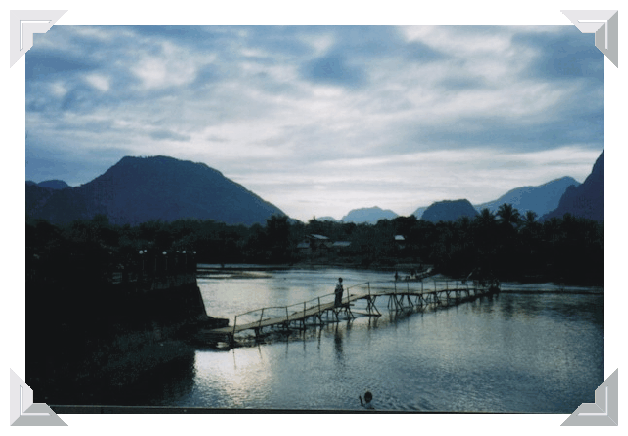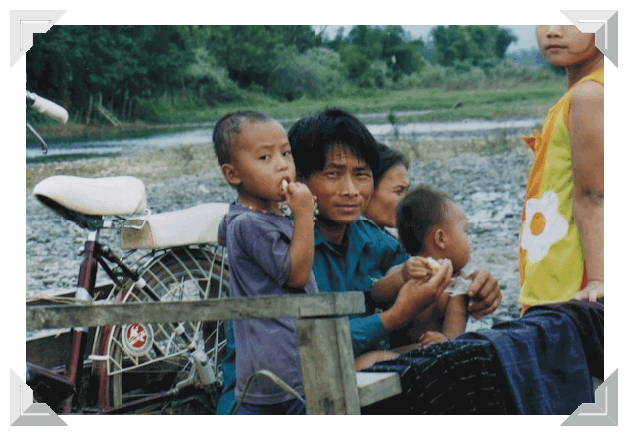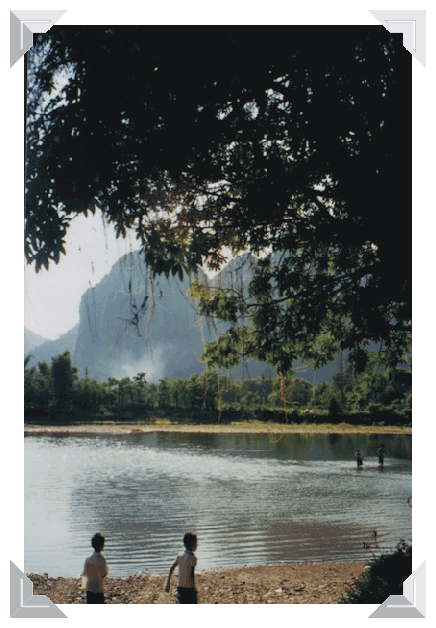

by

Laos - the sleepy hollow yet
charming backwater of South-East Asia. The country is quite the paradox:
formerly known as the land of a million elephants, it is the most bombed nation,
per capita, in warfare. Quaint little tourist retreat yet home to one of the
CIA's most clandestine wars. Adventure abounds in this tropical paradise, 4
million people in a land not yet jaded by tourism.
Today the country is more like
the land of a million unexploded ordnance (UXO), but luckily, or unluckily for
those that live there, they are concentrated in an area close to the Ho Chi Minh
Trial, where the B-52s, F-4s, F-105s, A-1s, A-107s and other American fighter
planes reigned their bombs in a futile attempt to stop North Vietnamese regulars
from infiltrating into southern Vietnam.
The country contains 68 ethnic
groups, yet it's the size of the UK, and it is landlocked in between China,
Burma, Vietnam, Thailand, and Cambodia. There is no railway and many of the
roads that do exist are virtually impassable during the rainy season. River
travel is the most efficient means of transport to many parts of the country.
Our trip starts in the magical
old capital of Luang Prabang. Writer Anthony Paul describes it thus, "this
glorious jumble of temples, markets and sidewalk stalls on the Mekong River
still manages to evoke another era.... it is one of the best destinations for a
traveler in search of `the way Asia once was' - that elusive Shangri-la which
old Asian hands refer when patronizing newcomers."
In 1995, the town and its 32
Buddhist temples were deemed a World Heritage Site which confirms "its
exceptional universal value as a cultural or natural site which deserves
protection for the benefit of humanity" (www.unesco.org/whc/sites/).
At rush hour, the town has been
described as a "cluster of bicycles with bells tinkling, a few motorbikes,
and the odd battered truck."
French explorer Henri Mouhot, the man who rediscovered Angkor Wat, died near Luang Prabang at age 35 of malaria but before he did, he wrote of the area, "I candidly confess that I have never been more happy than when amidst this grand and beautiful scenery... even if destined here to meet my demise, I would not change my lot...."

Mouhot, had taken ill at a cave
in nearby Ban Phanom, and monks had carried him to the riverside in hopes of
curing him. Unfortunately, he didn't make it, and today a white tomb engulfed by
forest in the middle of the wilderness marks his final resting spot. It's a nice
place to spend eternity.
Canadian businesswoman,
Catherine Stretch, says she ate some of the best food in her life in Luang
Prabang, in particular the steak and pate at the Cafe des Arts which is on
Thanon Xieng Thong, the town's trendy boulevard.
A nice guest house in town is
Ban Lao, not far from the Lao Aviation office. It's run by Santisouke Rathikoun,
whose father, Ouane, was the former commander-in-chief of the Royal Laos Army.
The Far East Economic Review has written a review of the place and quotes author
Roger Warner of Shoot up at the Moon as saying, "Ouane's name meant fat and
his greediness far outweighed his patriotic instincts." During the war, the
hotel was a base for US AID, or to put it another way, the CIA.
After the Pathet Lao took over
the country in 1975, they took the property away from the Rathikoun family and
put Ouane in a re-education camp in northern Laos where he eventually died. The
property was given back to the family two years ago and Santisouke has taken the
far from favorable review of his dad, photocopied it, and plastered it all over
the hotel's walls. Nothing like bad publicity to attract tourists.
Laos could be called "the
country of great sunsets." And if you are in LP a good place to watch the
kaleidoscope is from the boat restaurant opposite the Vinnida 2 Guest House.
From LP we travel to Phonsavan,
home of Laos' most mysterious spot, the Plain of Jars: dozens of huge stone
jars, carved out of solid rock. It's the country's "Stonehenge" or
"Easter Island" to be more precise. How did they get there, what are
they doing there? So many theories have been put forth but the most plausible
seems to be that King Khun Chuang stored wine in them back in the sixth century
to celebrate his future conquest of the province. There is also speculation that
they were later used as sarcophagi. You can travel to Phonsavan by road, but I
recommend you fly in. It's only a US$35 flight from Luang Prabang and the view
is spectacular.
There are a number of jar sites,
but only are three fit for tourist visitation. The first, the biggest, is Site
1, or Thong Hai Hin, and it contains the most jars and the largest one as well.
But the site, near a Laos Air Force base, is just not that scenic. Site 2, Hai
Hin Phu Salato, and site 3, Hai Hin Laat Khai, are much more pleasing to the
eye.
A good guide to the sites is
Sousath Pethrasy, the owner of the
Maly Hotel in Phonsavan, who has been described as "a hunter, hotelier,
tourist guide, citizen and survivor."
His father, Soth, was the former Laotian ambassador to Russia and the
Pathet Lao point-man in Vientiane during the Indochina conflict. A real
character, Sousath, who dresses in pilot coveralls, a Tom Mintier-CNN style
reporting vest and dark sunglasses, spent years in a cave in the Viengsai
district of Laos, where he learned his English from downed American airman,
Lawrence Bailey. He has discovered some of the lesser-known jar sites himself
and he can spin many a yarn. His hotel is chalk-full of old war weapons,
including the fuel tank from a downed MIG fighter. As someone said if Sousath
doesn't know about it, it probably didn't happen.
During the Indochinese conflict
the CIA had their staging base at Long Tieng, only a few km away from Phonsavan.
It was the second biggest city in Laos at the time, but officially it didn't
even exist. One figure is that for every person living in the area, 300 kgs of
bombs where dropped on them but the villagers have shown remarkable ingenuity
using all the spent ordnance as building materials. As a result, bomb casings
now serve as fence links or supports for homes on stilts. On a sad note,
however, many children in an attempt to impress their parents try bringing home
some harmless looking cluster bombs and end up losing their lives or limbs as a
result.
Next on the agenda, is the
country's capital, Vientiane (flying is easiest, and relatively cheap US$44 one
way on Laotian Air.) Once, it was one of the great cities of Indochina but today
it's a shadow of its former self. The Lonely Planet, however, does recommend a
great architectural walking tour which is definitely worth checking out. A good
place to stop and chill along the way is the Scandinavian Bakery near the
Fountain Circle which has a variety of great munchies.
Wandering a little farther
afield, you might be surprised to find a replica of the Arc de Triomphe, called
Patuxai, which was built with concrete absconded from US AID during the Vietnam
War which had been earmarked for a new airport.
About 25 km south of town is
Xieng Khuan or "Buddha Park."
Lying buddhas, standing buddhas, sitting buddhas, buddhas everywhere and
anywhere is the theme of this Laotian Disneyland.
Vientiane also has may great places to watch the sunset. Pick any open air restaurant near the corners of Thanon Fa Ngum and Thanon Nokeo Khumman and have a great time gabbing away and watching the sun go down over the mighty Mekong.

"You are given a thin
floral sarong as faded as the curtains from an abandoned house. The door of the
handsome wooden sauna, sealed with damp rags, keeps out all shred of light.
Acrid smoke chokes you for a few minutes, but if you hold out, astonishing waves
of sweat pour from your skin and the smoke becomes intoxicating. After twenty
minutes, thoroughly cleansed, orange herbal tea in glass tumblers has appeared
though the server has vanished.
"Another forty minutes. The
assistant appears and begins the massage - precise, vigorous, and very thorough
for the next hour. No conversation is necessary for the shy Lao people.
Appointments, name cards or receipts have no place here."
(5,000 kip sauna, 10,000 kip
massage, ATW: US$1= 7,500 Laos kip)
The sauna itself contains many
medicinal herbs including eucalyptus, tamarind, carambola and orange leaves
which are added to a drum of water which is heated by a fire beneath it, and
then aromatic steam is guided through a pipe into the hut.
One of the real treats of
visiting Vientiane lies about 50 clicks downstream overlooking a scenic bluff on
the Nam Ngum River: the lovely eco resort of Lao (newly growing) Pako (forest).
It was started by Austrian Walter Pfabigan as a place to accommodate students
that were working for a Swedish reforestation company which was replanting the
area as it had previously been devastated by slash and burn agriculture. When
the students left, Walter decided to continue the complex as an eco-resort,
respecting the environment and working in harmony with the local surroundings
and resources.
The buildings on the 50 hectare
site are constructed from natural native materials using local Laos carpentry
techniques. It is a incredibly serene spot, with glorious pinkish-purple
sunsets. "No disco, glaring lights, blaring video or karaoke" as one
guest put it. Just sit and listen to the silence. Lots of great nature walks and
just a tremendous place to relax.
If you are up for it, try the
local villagers favorite drink, Lau Lao, a rice whiskey concoction which
includes snake, tree bark and elephant and buffalo innards.
About 160 km north of Vientaine
lies Vangvieng, simply one of the most beautiful spots in all of South-East
Asia. With its karst topography, it is a glorious spot to while away a few days.
Mountain-bikes can be rented and there all kinds of fascinating areas to go
riding, exploring and spelunking. Alom Thavonsouk owns the Sunset Cafe and
Thavonsouk Bungalows, the nicest property in town. This eco-minded Laotian
entrepreneur, who has family in Canada, collects antique cars and runs a
nightclub in Vientiane as well.
Photographer Michael K. Elmore,
who recently completed a photo assignment in Laos, said, "the people of
Laos were friendly, open and very tolerant of my inability to speak their
language. They allowed me to photograph a part of Laos that I had not seen
before, and my days were totally magical." Very well put.
The Laotians and their neighbors
in Issan, in northern Thailand, are the Newfoundlanders of the region - they
don't get any respect, although they do provide the backbone of the Thai service
industry and they drive the Thai economy, especially between 1986-96 when
Thailand had the highest economic growth rate in the world. They are constantly
the butt of jokes for their supposed lack of intelligence and uncivilized ways -
but the truth is that they are a kind and gentle people who will not harass you
and will treat you very well. They are truly a delight to deal with. They are an
unfortunate people who just happened to be pawns caught between the major cold
war powers and they suffered horribly because of it.
Lao Aviation flies once a week
on Tuesday from BKK to LP (11:55 - 13:40), and from LP to BKK (9:10 - 10:55).
email: laoaviation@laoaviation.com
website: WWW.laoaviation.com
Vientiane office:
Tel: (856-21) 212051-3
Fax: (856-21) 212065
Bangkok office:
(662) 236-9822/3; 237-6982
******
Thai flies to Vientiane from BKK
everyday at 8:20, and from
Vientiane to BKK everyday from 10:35 - 11:45. Flights are 70 minutes.
Thai flies to Chiang Rai four
times a day, five on Sundays.
Tel: (662) 545-1000
*****
Angel Air flies to LP: We and Su
at 12:15 - 13:25
M and Fri at 10:20 - 12:55 (stop in
Chiang Rai)
Angel Air flies to BKK: We and
Su at 14:10 - 15:20
M and Fri at 13:40 - 16:15 (stop in
Chiang Rai)
Bangkok office
Tel: (662) 953-2260, 535-6287-8
Fax: (662) 535-6287
The fast boat trip from Huay Xai
to Luang Prabang costs about US$25. You cross over from the Thai town of Chiang
Khong and the nearest major Thai town to that is Chiang Rai (both Thai Airways
and Angel Air fly there). You cross over the river in the morning, go to
immigration, travel down the road a bit and line up to hop on one of the many
boats heading downriver.
Taking the fast boat all the way
amounts to 300km in 5-6 hours - not exactly a leisurely cruise down the Mekong.
The boat can seat six, but it's
a tight fit so many travelers travel five max and share the extra cost for the
sixth person. Be warned, if you travel in December and January bundle up because
it can get cold. And bring earplugs too.
The slow boat takes two days and
is a bit cheaper (about US$10). It travels about six hours a day and stops in
Pakbeng, a nice little sleepy town on the Mekong, which knows it has the
monopoly on nearby food and accommodation for tourists.
Another option is go by slow
boat the first day, stay overnight in Pakbeng and then take the fast boat the
next morning which would get you to Luang Prabang in 2-3 hours.
If you are going by boat, visas
can be obtained at the border (US$50), but they are more expensive than in
Bangkok (US$30) and take a day to process so better to get it done
beforehand.
In Bangkok, you can obtain either a 15 or 30 day visa yourself at the Laotian embassy, or have a travel agent do it for you. Fifteen day visas are also available on arrival for US$30 at the Friendship Bridge separating Nong Khai, Thailand and Vientiane, and from the international airports in Luang Prabang and Vientiane.
The cheapest way to see the
country is by road. The best way to do this is to travel by overnight bus or
train from Bangkok to Nong Khai in northeastern Thailand. Then take a short
tuk-tuk ride to near the border where a government sanctioned bus will then take
you from Thai immigration over the Friendship Bridge to Laos immigration. If you
don't already have your Laotian visa, you can purchase one there for US$30. It's
the a forty-mine jumbo ride into the Laotian capital.
Route 13 will take you all the
way from Vientiane to Luang Prabang. But it's a long and arduous journey, and
takes about twelve hours, so I recommend splitting it by stopping off in
Vangvieng which is about four hours outside of Vientiane. The route itself is
magnificent, (rivalling the trip from Danang to Hue in Vietnam and the journey
from Medan to Lake Toba in Sumatra) especially as you get closer to Luang
Prabang.
If you want to go Phonsavan by
bus from Luang Prabang you have to go the long way around via Route 1 to Route 6
and this takes about sixteen hours. And then to get back to Vientiane, you have
to retrace your steps to LP, and then go back down to the capital from there.
The other way via Route 13 is still too dangerous.
Suggested Reading
Nothing can beat the Lonely
Planet Travel Survival Kit (www.lonelyplanet.com).
It's one of their best guide books and Joe Cummings has done an excellent job
of preparing and researching it.
Also good if you can get you hands
on it, Henri Mouhot's Travels in Siam, Cambodia & Laos (Oxford)
which recounts the explorer's marvellous adventures from 1858-60.
For background on the Vietnam
War: check out Christopher Robbins' excellent book The Ravens (Corgi)
as well as his Air America: The Story of the CIA's Secret Airline (Corgi).
Also, for more on the horrible
plight of the Hmong, try Tragedy in Paradise, G.P. Charles Weldon's memoirs
of his time spent in Laos from 63-74 (Asia Books).
Christopher Kremmer's Stalking
the Elephant Kings (Silkworm) is a great read, tracing the mystery of what
happened to the last King and Queen (Savang Vattana and Khamphoui) through modern
day events.
The Rough Guide also has a good travel book on Laos.
A great coffee table book to get a visual idea of the surrounding area is The Mekong by John Hoskin and the late Allen Hopkins (Post Publishing Co., also available on CD).
For more info
read:
Liquid
Laos by Dennis Duncan
FINIS